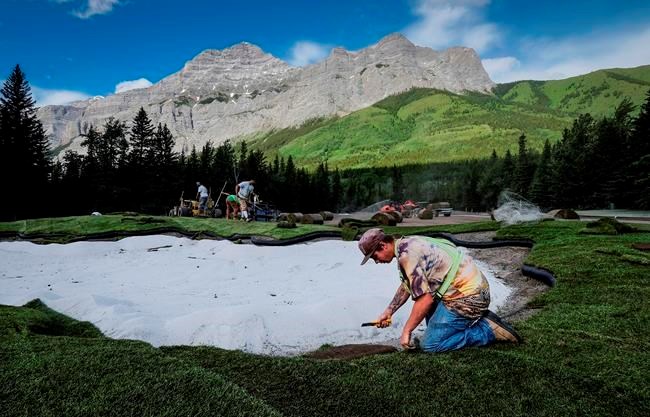The golf-mad old man would descend the stairs as early as 4:30 a.m., anxious to seize every available moment of Alberta's endless summer daylight.
"Boys," he would say, like a death row warden at dawn on execution day. "It's time."
Only in the Rocky Mountains did Dad's ungodly tee times invoke a sense of anything but dread. Not even the sore back and nauseating propane stench of sleeping in a truck bed camper could sully the thrill of waking up in a parking lot in Kananaskis Country.
You could still wear metal spikes back in 1983 when Kananaskis Country Golf Course first opened — a lush, verdant pair of Robert Trent Jones Sr. emeralds guarded on all sides by towering peaks and lodgepole pines, laced with glacier-fed rivers and dotted with brilliant white silica bunkers.
For the next three decades, K-Country's Mount Lorette and Mount Kidd courses would garner their share of attention, to be sure. But living in the shadow of Banff and Jasper's world-famous Stanley Thompson mountain masterpieces meant they never quite enjoyed the cachet they deserved.
Then suddenly, in June 2013, the rivers took it all back: higher-than-usual snow pack and several days of sustained heavy rains sent record floodwaters cascading down from the mountains, tearing apart the courses and smearing the valley with rocks, trees and debris.
For staff, the catastrophe marked the start of an arduous, emotional, will-they-or-won't-they journey — one that would go on to prove just how special a place Kananaskis Country was.
"I guess that's the silver lining, almost, to the whole thing," head pro Bob Paley said in an interview this week as the course offered a sneak peek at the progress to date.
"You have an idea that something's really special, but when you actually hear it — when you get a pat on the back or you get some nice things said about you, it really makes you feel good.
"Certainly, that's the feeling we got from all over the world."
Paley, golf architect Gary Browning and director of golf Darren Robinson were among those marking a major milestone Wednesday as they showed off the results to date of a years-long effort to restore the two layouts to their former glory.
Lorette is fully grassed and needs only time to mature before full-time play begins in spring 2018. The Mount Kidd course is more than halfway finished and has yet to see sod, but there's a chance — weather permitting — that it, too, could see play next year, said Paley.
Four years ago, that seemed unthinkable.
In the immediate aftermath of the flood, Kananaskis faced long odds indeed — longer still after 2015, when the New Democrats were elected in Alberta, ending the very 44-year Progressive Conservative dynasty that spawned the courses in the first place under former premier Peter Lougheed.
In the end, despite much political rancour, the NDP — buttressed by a favourable report from the province's auditor general — opted to let the $23-million rebuilding effort proceed. The government hopes to recoup much of the cost through Ottawa's disaster assistance program.
"With the NDP being elected, I didn't think it was going to proceed, to be honest," said Browning, whose Alberta-based design firm got the nod to take on what he described as a monumental restoration project.
"I think a vast majority of Albertans were happy to see that that was the decision. As an Albertan, and a golfer, I desperately wanted to see that project come back, just because of the value it held for Albertans and the value it held for the province as a tourist destination."
Notwithstanding some modest routing changes, players familiar with the two courses will recognize the original vision of Jones, the late British-born patriarch of a golf architecture empire that includes sons Rees Jones and Robert Trent Jr.
All three are known for stout, well-bunkered layouts that test every part of a player's game. Browning has softened Kananaskis slightly by flattening and enlarging its heavily contoured putting surfaces, shrinking bunkers and making approach shots less intimidating.
"It's still a very strategic test, that's for sure," he said. "I've kept my philosophy intact throughout, but I tried very hard to impart Jones's philosophy as well, which was, 'Difficult par, but easy bogey.' And I think we've maintained that."
Also back are those gorgeous bunkers and the blinding white silica sand that gave the course its distinctive look — and fuelled 30 years of rumours about its provenance.
"It's not helicoptered in from Saudi Arabia," Paley chuckled. "Sorry to burst everybody's bubble, but it comes from just down the street in Golden (B.C.)."
For Paley, the best part of the journey has been hearing from the friends, families and fans of Kananaskis checking in on social media from across Alberta, Canada and the world to survey the damage, offer condolences and moral support, and keep track of the rebuild.
Clearly, for multiple generations of golfers in Alberta, B.C. and elsewhere, Kananaskis Country is more than just a place to play — something Paley said he and his colleagues have known all along.
"Call it naivete or whatever you want to say, but I think all of us here felt like this place was just too important and too special for so many different reasons — to Albertans and to Canadians," he said.
"There's a lot of different things that could have happened, and certainly did, in those four years since the flood, but there was always a really strong sense — and a really strong belief — that these places were going to come back."
James McCarten, The Canadian Press, The Canadian Press

